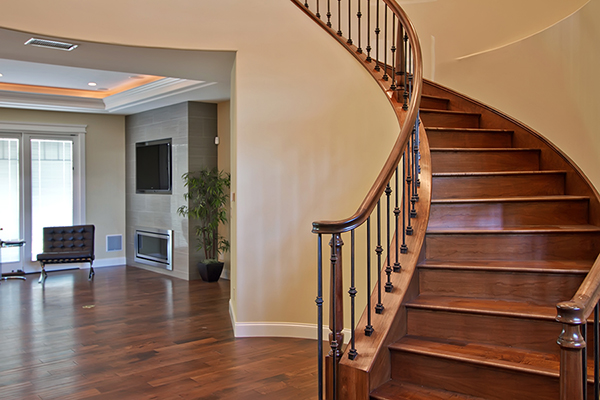Choosing the right stairs for your home is a crucial decision that impacts both the aesthetic appeal and functionality of your living space. Whether you are building a new house or renovating an existing one, the staircase is a significant element that can enhance the overall design and usability of your home. For residents of Brampton, a city known for its diverse architectural styles and vibrant community, selecting the perfect staircase involves considering various factors such as design, materials, safety, and space optimization. Here are some expert tips to help you make an informed decision.
1. Understand Your Space and Layout
Before choosing a staircase, assess the available space and layout of your home. The size and shape of the area where the staircase will be installed will significantly influence your options. Common staircase types include straight, L-shaped, U-shaped, spiral, and curved.
- Straight Stairs: These are the simplest and most common type, ideal for homes with ample space. They are easy to install and navigate but may require more room compared to other designs.
- L-Shaped Stairs: These have a 90-degree turn, providing a visual break and saving space. They are suitable for corner spaces and can add an interesting architectural element to your home.
- U-Shaped Stairs: Also known as switchback stairs, they consist of two parallel flights with a landing between them. They are compact and provide efficient use of space.
- Spiral Stairs: These are perfect for tight spaces and add a dramatic flair to your home. However, they can be challenging to navigate and may not be suitable for homes with elderly or young children.
- Curved Stairs: These offer a grand and elegant look, often used in larger homes. They require more space and can be more expensive to build but provide a beautiful focal point.
2. Choose the Right Materials
The materials you choose for your staircase will affect its durability, maintenance, and overall aesthetic. Here are some popular materials and their characteristics:
- Wood: A classic and versatile choice, wood offers warmth and can be easily customized. Popular wood types include oak, maple, cherry, and walnut. Wooden stairs require regular maintenance to prevent wear and tear.
- Metal: Metal stairs, such as those made from steel or aluminum, provide a modern and industrial look. They are durable and require less maintenance than wood. However, they can be noisy and may not fit all design styles.
- Glass: For a contemporary and open feel, glass stairs are an excellent option. They allow light to pass through, making your space feel larger. Glass stairs require frequent cleaning to maintain their transparency and safety.
- Stone: Marble, granite, and other natural stones offer a luxurious and timeless appeal. Stone stairs are durable and easy to maintain but can be expensive and require a strong structural foundation.
3. Prioritize Safety
Safety is a critical consideration when choosing a staircase, especially if you have children, elderly family members, or individuals with mobility issues in your home. Here are some safety tips:
- Railing and Balustrades: Ensure your stairs have sturdy handrails and balustrades to provide support and prevent falls. The spacing between balusters should be small enough to prevent small children from slipping through.
- Non-Slip Treads: Opt for non-slip materials or add non-slip strips to the treads to reduce the risk of slipping. This is particularly important for stone, glass, or metal stairs.
- Lighting: Proper lighting is essential to ensure visibility and safety. Install lights along the stairway, including at the top and bottom of the stairs. Consider motion-sensor lights for convenience and energy efficiency.
- Uniform Riser Heights: Ensure that the riser heights are consistent throughout the staircase to prevent tripping. The recommended riser height is between 7 and 8 inches.
4. Consider the Aesthetic and Style
Your staircase should complement the overall style and décor of your home. Here are some design tips based on different styles:
- Traditional: For a classic look, opt for wooden stairs with ornate balustrades and handrails. Choose rich wood tones and add carpet runners for a warm and inviting feel.
- Modern: Sleek and minimalist designs work well for modern homes. Consider metal or glass stairs with clean lines and minimalistic railings. Neutral colors like black, white, or grey can enhance the modern aesthetic.
- Rustic: For a cozy, rustic vibe, choose reclaimed wood or natural stone stairs. Add wrought iron railings and incorporate warm, earthy tones.
- Contemporary: Mix materials like wood and metal for a contemporary look. Floating stairs, which appear to be suspended without visible support, can add a striking visual element.
5. Factor in Maintenance and Durability
Different materials and designs require varying levels of maintenance. Consider the following:
- Wooden Stairs: Regular cleaning and polishing are necessary to maintain the finish. Wood can be prone to scratches and dents, so protective finishes or carpeting may be needed.
- Metal Stairs: These are generally low-maintenance but can rust if not properly treated. Regular cleaning and occasional repainting may be required.
- Glass Stairs: Frequent cleaning is necessary to keep them free of smudges and fingerprints. Ensure the glass is tempered for safety.
- Stone Stairs: These are durable and easy to clean. However, they can be prone to staining, so sealing the stone can help protect against spills.
6. Budget Considerations
Staircases can vary significantly in cost depending on the materials, design complexity, and labor involved. Set a realistic budget and consider the following:
- Material Costs: Wood and metal stairs are generally more affordable than glass or stone. However, high-end wood types and custom metal designs can be expensive.
- Installation Costs: Straight stairs are the most cost-effective to install, while curved or custom-designed stairs can be more expensive due to the complexity of the work.
- Additional Features: Features like lighting, non-slip treads, and decorative elements can add to the overall cost. Prioritize features that enhance safety and functionality.

7. Local Building Codes and Regulations
Ensure that your staircase design complies with Brampton’s local building codes and regulations. These codes dictate specific requirements for dimensions, railings, and safety features. Consulting with a professional contractor or architect can help you navigate these regulations and ensure your staircase is up to code.
8. Seek Professional Advice
Working with an experienced architect, interior designer, or contractor can provide valuable insights and ensure that your staircase is both functional and aesthetically pleasing. Professionals can help you:
- Design Custom Solutions: Tailor the staircase to your specific needs and preferences.
- Ensure Structural Integrity: Verify that the staircase is safe and well-constructed.
- Optimize Space: Make the best use of the available space while maintaining a cohesive design.
- Stay on Budget: Provide cost-effective solutions without compromising on quality.
Conclusion
Choosing the right stairs for your Brampton home is a decision that requires careful consideration of various factors, including space, materials, safety, design, maintenance, budget, and local building codes. By understanding your needs and working with professionals, you can select a staircase that enhances both the functionality and aesthetic appeal of your home. Whether you prefer the classic elegance of wooden stairs, the modern look of metal and glass, or the rustic charm of reclaimed wood, the perfect staircase can transform your living space and add value to your home.


